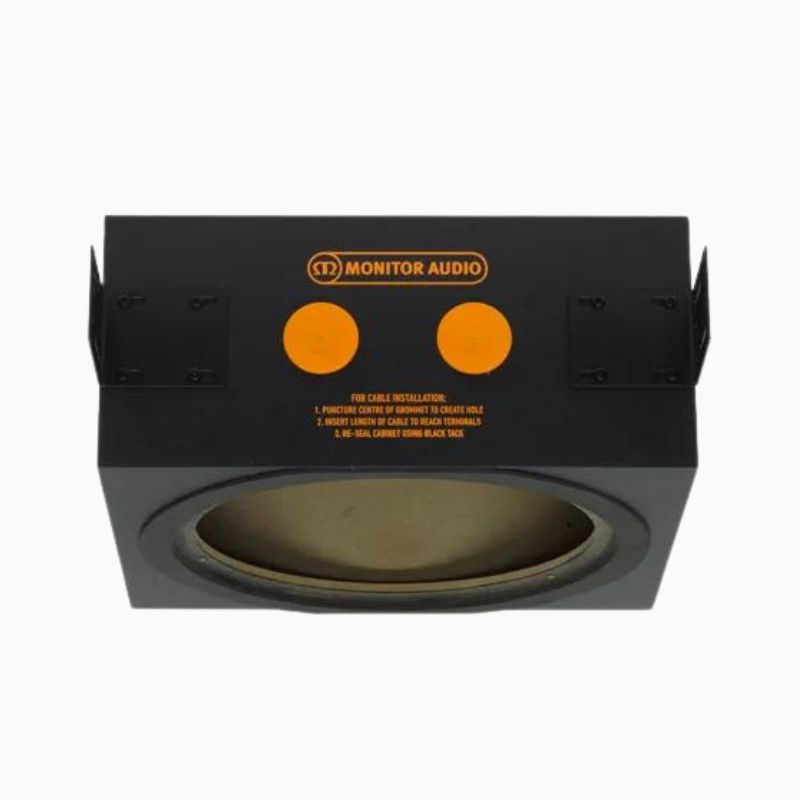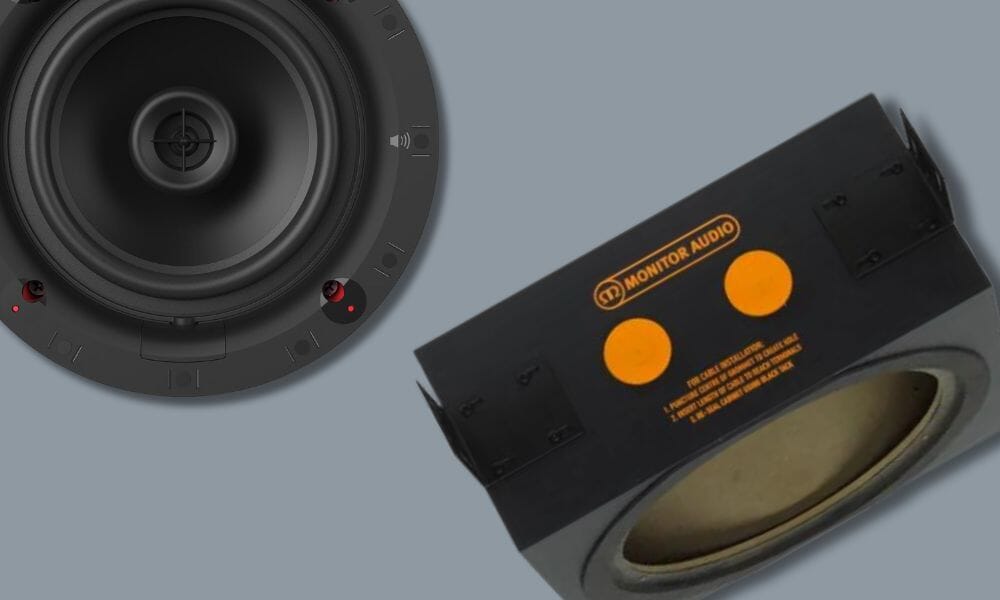Ceiling speakers, especially those installed in ceilings with open spaces above them, can benefit from the use of a back box.
A back box, also known as an enclosure or back can, is a housing that surrounds the back of the speaker, providing a sealed space behind it.
Here are some reasons why using a back box for ceiling speakers might be recommended:
The Basics: What is a Back Box?
Before we start gallivanting off into the technicalities, let's first understand what a back box is.
If you take a look at your average bookshelf speaker you'll note that the drivers (the actual speaker) is installed into a large enclosure which is essential to provide the final sound quality.
In the simplest of terms, a back box is a container that is installed behind a ceiling speaker to provide a sealed space.
It's usually made out of MDF, you can buy ready-to-install enclosures or you could make your own.
This is a ceiling speaker back box:

They're like the unsung heroes of the audio world, quietly doing their job behind the scenes while the speakers take all the glory.
Do Ceiling Speakers Need a Back Box?
Now, onto the million-pound question: do ceiling speakers need a back box?
Well, the answer is a classic one: it depends.
Ceiling speakers require some form of back box in order to sound good. If you've ever tried to "test" your ceiling speakers on the side before installation you'll note that they sound terrible, they're really quiet and won't have any bass at all.
Once installed into the ceiling though, the void forms the speaker enclosure and significantly improves the volume, bass and sound quality.
So as you can start to imagine, if a standard ceiling void transforms your speakers then a dedicated, controlled enclosure can take it to the next level.
It's worth noting that some speakers have already enclosed and are designed to work optimally without an additional back box.
Lastly, your personal preferences and needs come into play.
If you're all about that bass and want the best sound quality possible, a back box might be a worthy investment. However, if you're just looking for a simple setup for casual listening, you'll be able to get by without one.
Benefits of Using a Back Box
Improved Sound Quality
One of the main benefits of using a back box is the improved sound quality.
By providing a sealed space for the speaker, a back box can help to enhance the bass response and overall audio clarity. It's like giving your speaker a megaphone, allowing it to project sound more effectively.
Furthermore, a back box can help to reduce unwanted vibrations that can distort the sound.
Reduced Sound Leakage
Another advantage of using a back box is the reduction in sound leakage.
Without a back box, sound can easily escape through the ceiling and into other rooms, which might not be ideal if you're trying to enjoy a late-night movie marathon without waking the whole house.
With a back box, the sound is contained within the speaker's immediate vicinity, allowing you to crank up the volume with less chance of disturbing your neighbours or family members.
Consistent Sound Performance
In some cases, a back box can provide a consistent and predictable environment for the speaker, helping it reproduce sound more accurately.
This is especially relevant in situations where the ceiling structure or the space above the ceiling may vary.
Drawbacks of Using a Back Box
Additional Cost
While a back box can offer several benefits, it's not without its drawbacks.
One of the main downsides is the additional cost.
Depending on the type and quality of the back box, it can add a significant amount to your overall speaker setup cost.
It's like ordering a fancy dessert at a restaurant - it might enhance your dining experience, but it'll also make your bill a bit heftier.
Installation Complexity
Another potential downside is the added complexity during installation.
Installing a back box requires a bit more work and expertise compared to a simple speaker setup and they must be installed when the ceilings are down.
So if you're doing a retrofit project then it's unlikely that you can fit ceiling speaker back boxes even if you wanted to...
Fire Protection
When you cut a hole in the ceiling you're required to ensure that the fire rating of the ceiling is maintained.
In the UK that's usually a 1 hour rating.
So, cutting a big hole is going to destroy that rating and unfortunately filling it with a ceiling speaker and MDF enclosure isn't going to resolve the issue as both items aren't fire-rated as standard.
If you're using a back box you will still need to either;
- Fire rate the enclosure with relevant fire rated materials
- Install a ceiling speaker fire hood

Another option is to use a fire & acoustic ceiling speaker fire hood.
These not only provide the required fire ratings for your ceilings, they will also improve the sound quality and reduce sound leakage above by a few decibels.
Whilst not as effective as a proper MDF back box this option is cheap and easy to install and it ticks two boxes with one product. (fire and acoustic)
Read More: Do Ceiling Speakers Need Fire Hoods?
Conclusion
So, do ceiling speakers need a back box?
As we've discovered, it's not a straightforward yes or no answer.
It depends on your ceiling type, speaker type, and personal preferences. A back box can certainly enhance your audio experience, but it's not a necessity and most of our customers do not fit specific back boxes.
Ultimately, the decision is in your hands (or ears, in this case).
Whether you decide to go for a back box or not, the most important thing is that you enjoy your audio experience. After all, life's too short for bad sound, isn't it?


